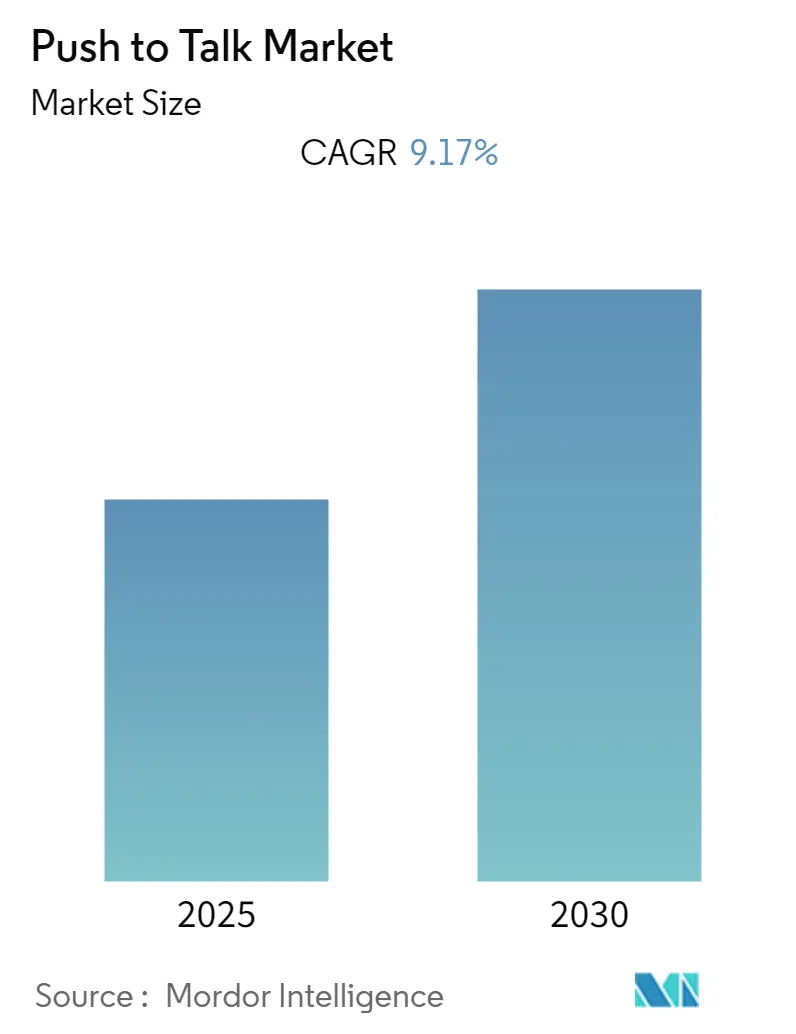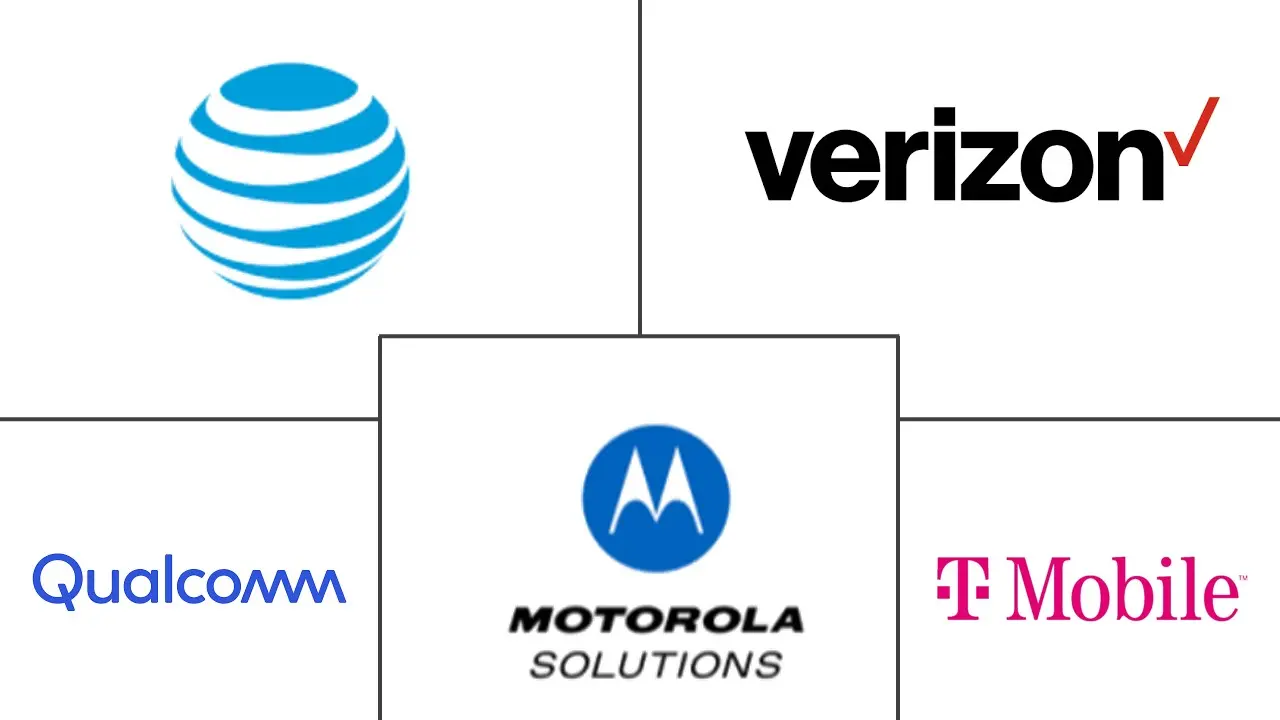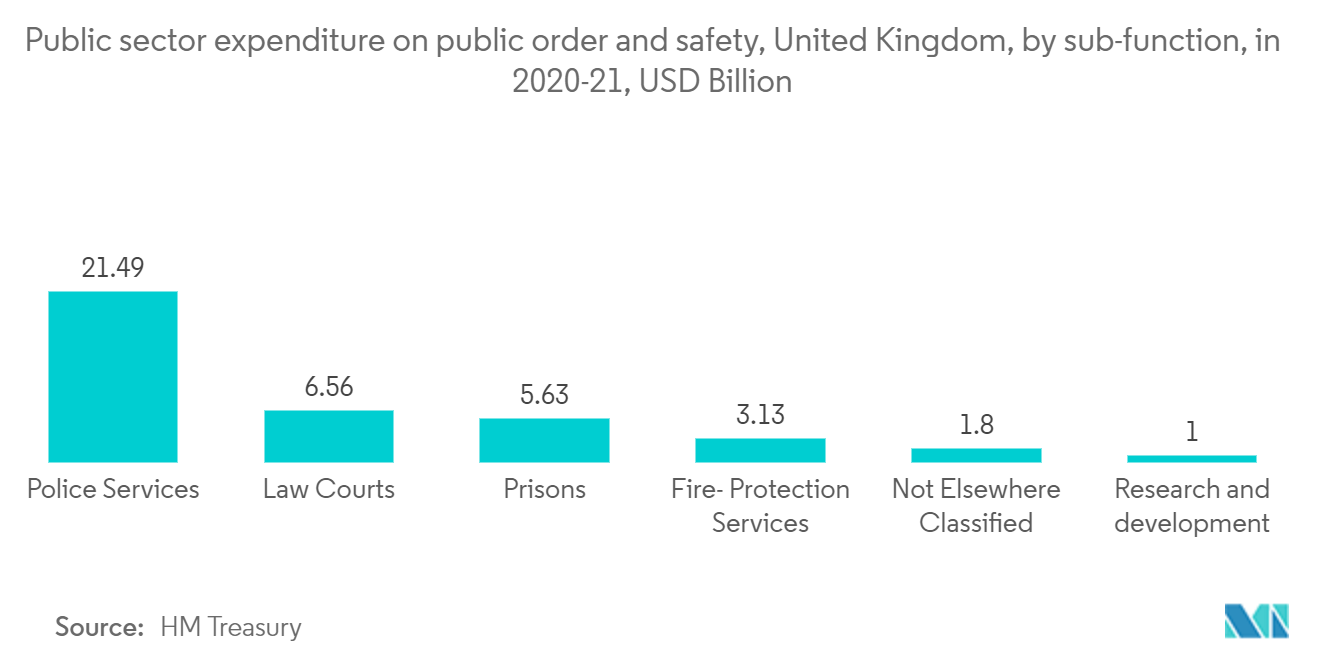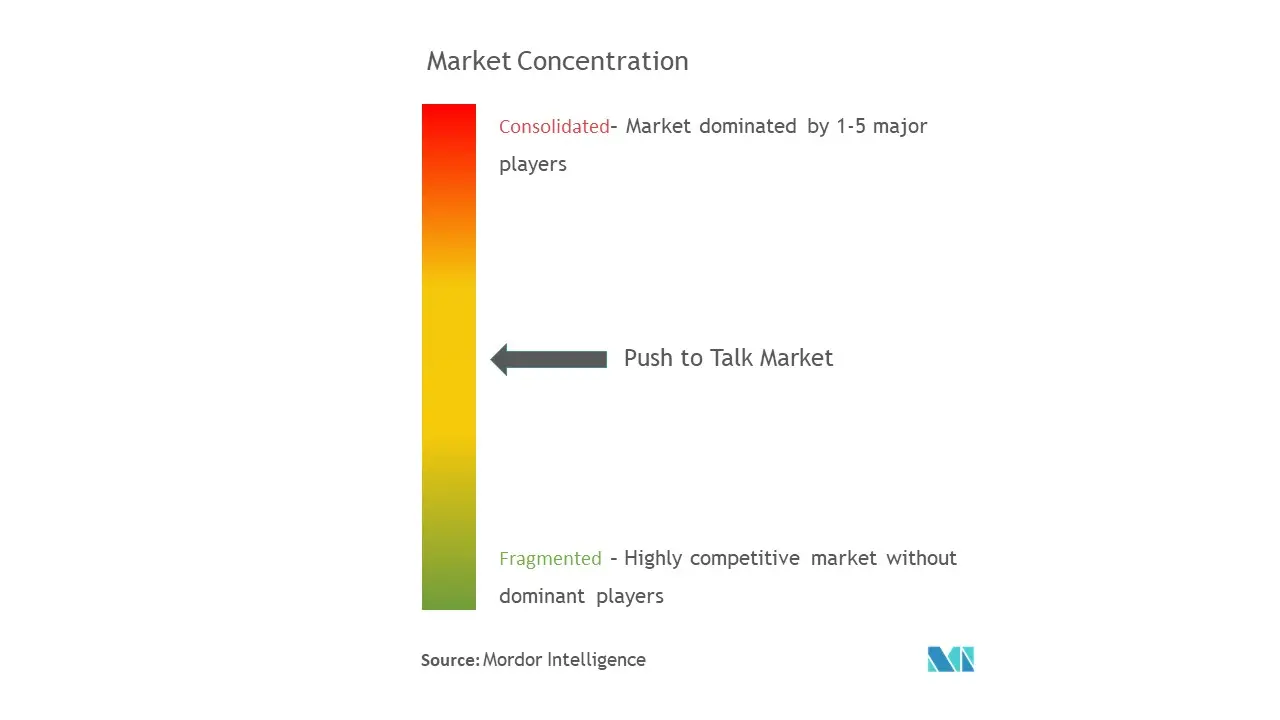Push-to-Talk (PTT) Market Size

| Study Period | 2019 - 2030 |
| Base Year For Estimation | 2024 |
| Forecast Data Period | 2025 - 2030 |
| CAGR | 9.17 % |
| Fastest Growing Market | Asia-Pacific |
| Largest Market | North America |
| Market Concentration | Medium |
Major Players
*Disclaimer: Major Players sorted in no particular order |
Push-to-Talk (PTT) Market Analysis
The Push to Talk Market is expected to register a CAGR of 9.17% during the forecast period.
- During the projection period, market participants will benefit greatly from evolving technologies such as the Internet of Things (IoT), artificial intelligence (AI), natural language processing, and expanding online applications. Additionally, major market players use marketing techniques, such as mergers and acquisitions, to grow their businesses internationally. For instance, last year, a France-based SaaS company Sendinblue acquired PushOwl. This bootstrapped Indian start-up makes an online marketing tool for e-commerce stores to enable web push notifications.
- Increasing utilization of PTT over LTE networks has benefitted businesses from expansive commercial coverage, which is quite more prominent than that provided by shared or private LMR networks. Also, PTT over cellular extends communications beyond the single function of voice to include video, data, and connectivity with back-end business systems. Additionally, PoC offers a greater selection of affordable and ruggedized end-user device options, including feature phones, smartphones, and phablets, providing the mobile solution for virtually any type of worker and work environment at a low cost compared to LMR and rugged two-way radios.
- Surging demand for digitalized products due to the advantages over analog products is expected to propel the demand for PTT in the forecast timeframe. Digitized devices provide Machine-to-Machine (M2M) support and other high-end Industrial Internet of Things (IIoT) applications by providing a strong communication experience and greater spectrum efficiency. Industries may provide voice and data services, including M2M applications, on a highly dependable network that provides coverage over the full-service zone by utilizing modern digital mission-critical LMR systems.
- In the anticipated timeframe, a delay in the standardization of spectrum allocation will impede the market growth. The main advantage of constructing the 5G network is higher frequencies. However, it is still being determined when wireless carriers will be granted access to these spectrums to deploy 5G infrastructure.
- The push-to-talk market experienced minimum effect during the COVID-19 pandemic, as the demand for push-to-talk over cellular is still highly preferred for public safety and security application. The push-to-talk over cellular devices is extensively used by disaster management and government agencies, especially in COVID-19 hotspots for communicating in those areas. Industry experts also suggest that the push-to-talk over cellular equipment is a game-changer technology for public-safety communications.
Push-to-Talk (PTT) Market Trends
This section covers the major market trends shaping the Push to Talk Market according to our research experts:
Public Safety and Security Sector to Witness the Highest Adoption of PTT Devices
- The increasing adoption of PTT devices like specialized feature phones, ultra-rugged devices, and smartphones in the public safety and security domain is expected to drive the market. Numerous global public safety companies, such as Honeywell, 3M, and Phoenix Health and Safety, are employing push-to-talk solutions owing to features and innovative benefits.
- Additionally, public authorities communicate using these devices, such as walkie-talkies, during emergencies. Players in the market are focusing on launching new products to strengthen their geographical presence. For instance, last year, Siyata Mobile Inc., one of the global vendors of Push-to-Talk over Cellular (POC) devices and cellular signal booster systems, announced that United States Cellular Corporation, the fourth-largest wireless carrier in the United States with 4.8 million retail connections in 21 states, will launch Siyata's rugged SD7 device onto their network.
- Public safety communications networks should be secure, resilient, dependable, and accessible. Current mobile broadband cellular networks fail to meet public safety requirements and interoperability. Therefore, numerous forms of LMR networks with differences in capabilities, interfaces, and operation are being developed by many organizations for commercial, private, and public safety applications.
- The other factors accountable for the segment's growth are the rising need for cost-effective services, government initiatives, and the adoption of cloud-based PTT solutions. Improved compliance, such as DOT compliance and surging investment and R&D activities to upgrade push-to-talk solutions, are expected to drive market growth. Additionally, increasing public expenditure for order and safety is expected to propel the demand for the PTT market. For instance, according to HM Treasury, the United Kingdom spent around 38.6 billion on public order and safety, with the highest area of spending being police service, which accounted for GBP 21.49 billion.

North America Accounted for a Substantial Share in the Forecast Period
- With the rising penetration of core technologies and the presence of telecom service providers and PoC vendors, such as AT&T and Motorola Solutions, the demand for the market will grow in the projected timeframe. Also, the growing demand for efficient and cost-effective solutions is the key factor driving the demand in North America.
- The United States has a major share in the North American market owing to the rising adoption of push-to-talk solutions among various end-use industries such as public safety organizations, government and defense, healthcare, and others. Thus, key players in this market are focused on adopting product expansion strategies to cater to the rising demands for efficient and cost-effective solutions.
- The rapid expansion of the North American push to the talk market is attributed to the high adoption of ultra-rugged smartphones and the fast speed of cellular infrastructure construction in the United States and Canada. Key companies, including Verizon Wireless, AT&T, Sprint, and Motorola Solutions, are present in the United States that substantially impact the expansion of the push-to-talk industry.
- The regional players are also focusing on launching new products for noise suppression and high-volume speakers for loud environments. For instance, this year, Hytera US, a supplier of two-way radios, launched PNC360S Push-to-Talk over Cellular radio. The newly launched product PNC360S supports instant group and individual voice calling over nationwide wireless networks and push-to-talk over local Wi-Fi networks, as programmed by the user.

Push-to-Talk (PTT) Industry Overview
The push-to-talk market is moderately competitive, owing to the presence of many small and large players. The market is concentrated with the key players adopting strategies, such as product innovation, to stay ahead of the competition. Some of the players in the market are AT&T Inc., Verizon Wireless, Motorola Solutions Inc., T-Mobile, and Qualcomm Technologies, Incorporation.
- In May 2022: The UK Home Office officials planned to seek a mission-critical-push-to-talk (MCPTT) service from a vendor other than Motorola Solutions for the Emergency Services Network (ESN). Still, it has asked the Competition and Market Authority (CMA) to impose new interworking requirements on Motorola Solutions.
- In February 2022: Thuraya Telecommunications Company, a subsidiary of the UAE's flagship satellite solutions provider, Al Yah Satellite Communications Company PJSC, announced that it launched its new IP-based radio communications solution, Thuraya Push-to-Talk (PTT). The new solution would allow users to create private networks and integrate different technologies.
Push-to-Talk (PTT) Market Leaders
-
AT&T Inc.
-
Verizon Wireless
-
Motorola Solutions, Inc.
-
T-Mobile
-
Qualcomm Technologies, Incorporation
*Disclaimer: Major Players sorted in no particular order

Push-to-Talk (PTT) Market News
- In July 2022: Sonim Technologies announced the launch of the XP5plus on the AT&T network; this will offer the best of both cellular and radio-like capabilities for businesses and employees working in extreme conditions. The XP5plus is built on the legacy of its predecessor, the XP5s, which is one of the most widely used PTT-over-Cellular ultra-rugged devices among frontline workers and first responders who need instant, reliable communications when it matters most.
- In July 2022: Inmarsat launched a seamless Push-To-Talk Communications solution with Cobham, Hytera, and global beam telecom. The new partnership will provide market-leading end-to-end connectivity solutions to prevent downtime for radio users in Middle Eastern enterprise businesses.
Push-to-Talk (PTT) Market Report - Table of Contents
1. INTRODUCTION
1.1 Study Assumptions and Market Definition
1.2 Scope of the Study
2. RESEARCH METHODOLOGY
3. EXECUTIVE SUMMARY
4. MARKET INSIGHT
4.1 Market Overview
4.2 Industry Attractiveness - Porter's Five Forces Analysis
4.2.1 Threat of New Entrants
4.2.2 Bargaining Power of Buyers/Consumers
4.2.3 Bargaining Power of Suppliers
4.2.4 Threat of Substitute Products
4.2.5 Intensity of Competitive Rivalry
4.3 Assessment of the Impact of COVID-19 on the Market
5. MARKET DYNAMICS
5.1 Market Drivers
5.1.1 Evolving Technologies to Support Growth
5.1.2 Proliferation of Rugged and Ultra-rugged Smartphones
5.1.3 Increasing Transition of Analog LMR Systems to Digital LMR Systems
5.2 Market Challenges/Restrain
5.2.1 Delay in the Standardization of Spectrum Allocation
6. MARKET SEGMENTATION
6.1 Component
6.1.1 Hardware
6.1.2 Solutions
6.1.3 Services
6.2 Network Type
6.2.1 LMR
6.2.2 Cellular
6.3 Vertical
6.3.1 Public Safety
6.3.2 Government and Defense
6.3.3 Commercial
6.4 Geography
6.4.1 North America
6.4.2 Europe
6.4.3 Asia-Pacific
6.4.4 Latin America
6.4.5 Middle East and Africa
7. COMPETITIVE LANDSCAPE
7.1 Company Profiles
7.1.1 AT&T Inc.
7.1.2 Verizon Wireless
7.1.3 Motorola Solutions Inc.
7.1.4 T-Mobile
7.1.5 Qualcomm Technologies Incorporation
7.1.6 Iridium
7.1.7 Tait Communications
7.1.8 Zebra
7.1.9 Telstra
7.1.10 Hytera
- *List Not Exhaustive
8. INVESTMENT ANALYSIS
9. FUTURE OF THE MARKET
Push-to-Talk (PTT) Industry Segmentation
Push-to-talk (PTT), often referred to as press-to-transmit, is a way to have conversations or communicate on half-duplex communication lines, such as two-way radio, by pressing a temporary button to go from voice reception mode to transmit mode. It allows users to rapidly convey messages to one or more persons at once by simply pressing a button on a handheld device. To speak and listen, users push and hold the button.
The push to talk market is segmented by component (hardware, solutions, and services), network type (LMR and cellular), vertical (public safety, government and defense, and commercial), and geography (North America, Europe, Asia-Pacific, Latin America, and Middle East and Africa).
The market sizes and forecasts are provided in terms of value (USD billion) for all the above segments.
Push-to-Talk (PTT) Market Research FAQs
What is the current Push to Talk Market size?
The Push to Talk Market is projected to register a CAGR of 9.17% during the forecast period (2025-2030)
Who are the key players in Push to Talk Market?
AT&T Inc., Verizon Wireless, Motorola Solutions, Inc., T-Mobile and Qualcomm Technologies, Incorporation are the major companies operating in the Push to Talk Market.
Which is the fastest growing region in Push to Talk Market?
Asia-Pacific is estimated to grow at the highest CAGR over the forecast period (2025-2030).
Which region has the biggest share in Push to Talk Market?
In 2025, the North America accounts for the largest market share in Push to Talk Market.
What years does this Push to Talk Market cover?
The report covers the Push to Talk Market historical market size for years: 2019, 2020, 2021, 2022, 2023 and 2024. The report also forecasts the Push to Talk Market size for years: 2025, 2026, 2027, 2028, 2029 and 2030.
Push to Talk Technology Industry Report
Statistics for the 2025 Push to Talk market share, size and revenue growth rate, created by Mordor Intelligence™ Industry Reports. Push to Talk analysis includes a market forecast outlook for 2025 to 2030 and historical overview. Get a sample of this industry analysis as a free report PDF download.



